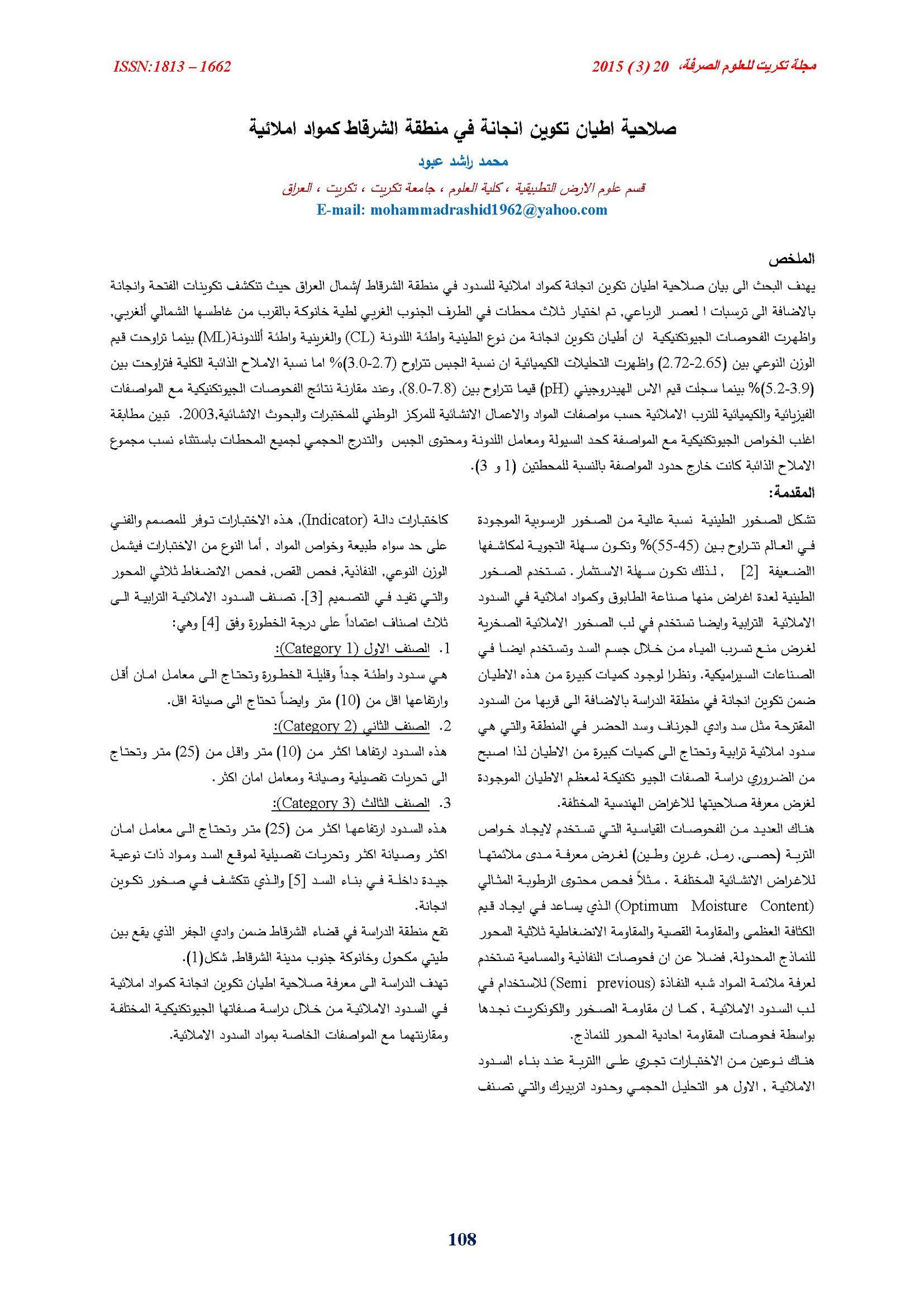Suitability of Injana Clays for filling Materials
Main Article Content
Abstract
The study aims to evaluate suitability of injana formation clays for filling material in Sharqad area / North of Iraq, The exposed rocks are Fat’ha & Injana Formations in addition to Quaternary deposits. Three stations are studied in southern west limb of Khanuqa anticline near the north western plunge of this anticline, Geotechnical properties show that the type of soil are low plasticity (CL)and low plasticity silt(ML).The specific gravity values ranges between (2.65-2.72), the chemical analysis show that the ratio of total dissolved salts ranges between (3.9-5.2)% ,while the ratio of gypsum content ranges(2.7-3.0)%, pH values ranges between (7.8-8.0).In last the most geotechnical properties of Injana clays are accepted as filling materials for earth fill dams when compare with Iraq specification (Sorb/rs) except the ratio of (TDS) for stations,1&3.
Article Details

This work is licensed under a Creative Commons Attribution 4.0 International License.
Tikrit Journal of Pure Science is licensed under the Creative Commons Attribution 4.0 International License, which allows users to copy, create extracts, abstracts, and new works from the article, alter and revise the article, and make commercial use of the article (including reuse and/or resale of the article by commercial entities), provided the user gives appropriate credit (with a link to the formal publication through the relevant DOI), provides a link to the license, indicates if changes were made, and the licensor is not represented as endorsing the use made of the work. The authors hold the copyright for their published work on the Tikrit J. Pure Sci. website, while Tikrit J. Pure Sci. is responsible for appreciate citation of their work, which is released under CC-BY-4.0, enabling the unrestricted use, distribution, and reproduction of an article in any medium, provided that the original work is properly cited.
References
2. Tucker, M.E., 1985, Sedimentry petrology, An Introduction, Black well science, pup1. Oxford, 252p.
3. Druyts,F.1985,Testing of materials and Soils, Hydaulic Structures, Equipment and water data Acquisition-Vol. IV.
4. Ancold, 2000, Australian National Committee on Large Dams Guidelines on Selection of Acceptable Flood Capacity for Dams (march,2000).
5. Harradine, Alan, 2008, Guidelines for the construction of earth-fill Dams
6. Jassim, S.Z. and Goff, J., C., 2006; The regional geology of Iraq,1st edition stratigraphy and paleogeography, Dar Al-kutib pub. House, Mosul, Iraq, 445p.
8. Buday,T. & Jassim,S.Z.,1984, Final Report of the Regional Geological Survey of Iraq, Unpublished Report. S.O.M. library, Vol 2, Tectonic frame work.
9. Dewey,J.F.,Pitman,W.C.,Baam, W.B.F. and Bonnin,J.,1973, Plate Tectonic and the Evolution of the Alpine System, AM.Bull.,84p
10. Fouad,S.F.,2002, Detailed Geological Survey of Khanuga Area, Geosurve., Baghdad ,Iraq, Internal Report,132p.
11. Bowles, J.E., 1984, Physical and Geotechnical properties of soil,2nd ed, Mc-Graw Hill Japan, Ltd. 578p.
12. ASTM,D854-02.,2004,Standard Test Methods for Specific Gravity of Soil Solids by water pycnometer.
13. Das, M. Braja, 1982, Soil Mechanics Laboratory Manual, the university of Texas at EL paso.
14. Al-Khafaji, A.W., and Andersland,O.B.,1992, Geotechnical Engineering and Soil Testing.
15. Dunn, I., Anderson, I., and Kiefer, F., 1980, Fundamental of Geotechnical Analysis , John Willey & Sons Inc, USA, 414p.
16. ASTM-E11, 2004, Standard Specification for Woven wire test sieves.
17. ASTM, D422-63., 2004, Standard Test Method for particle-size Analysis of soil.
18. ASTM, D-421, 2004, Standard Practice for dry preparation of soil samples for particle size analysis and determination of soil constants.
20. ASTM,D4318-00.,2004,Standard Test Methods for liquid limit, plastic limit and plasticity Index of Soils.
21. Hand book No.60, 1959, Diagnosis and Improvement of saline and Alkali soils, Agric ”US
Department of Agriculture (USDA) Washington,
D.C.
22. FSA Irrigation, 2001, Appendex E-Soils Classification Testing and Suitability Farm Dams for the Sugar Industry.
23. Yilmaz, I. and Karacan, E. , 1969, Geotechnical Characteristics and mineralogy of compacted clays used as an impervious core for the Camligoze Dam, Turkey. International Geology Review, 38 (10), 972-978.
